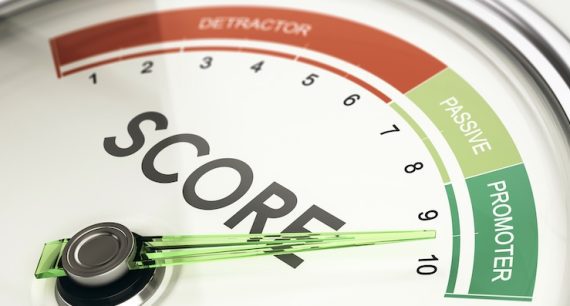Repeat purchases and average order value gauge customers’ satisfaction. But the gold standard is Net Promoter Score.
NPS measures the likelihood of customers recommending a company or product to others. It’s a quick, easy metric, used widely across industries and verticals. The simplicity facilitates benchmarks and easy comparisons to monitor performance over time and against competitors.
To find the NPS, ask customers to rate the prospect of recommending your company on a scale of 0 to 10 — “Not at all likely” to “Extremely likely.” The question is simple:
On a scale of 0 to 10, how likely are you to recommend [Company/Product/Service] to a friend or colleague?
The results group respondents as “Detractors” (scoring 0-6), “Passives” (7-8), or “Promoters” (9-10).

Group respondents as “Detractors,” “Passives,” or “Promoters.”
Calculating NPS
Promoters are highly satisfied, your most loyal customers. Passives are moderately satisfied but not necessarily enthusiastic. They may recommend your business if asked but can be tempted by competitors. Detractors are dissatisfied customers who are unlikely to buy again and could speak negatively about a business.
To calculate your NPS score, ignore the Passives and subtract the percentage of Detractors from the percentage of Promoters, as follows:
NPS = % Promoters – % Detractors
For example, if 60% of respondents are Promoters and 20% are Detractors, the NPS would be 40 (60 – 20).
Scores can range from -100 to +100. In my experience, a poor NPS ranges from -100 to -1. It means the business has a higher percentage of Detractors than Promoters.
An average NPS ranges from 0 to 30, indicating a mix of Promoters, Detractors, and Passives. A good score runs 31 to 70 — many satisfied and loyal customers. Finally, an excellent score is anything over 70. This is rare and reflects exceptional customer products and service.
No matter the score, there is always room for improvement. Use NPS as a yardstick; track progress with always-on surveys. Ask follow-up questions where appropriate for customers to explain their scores. These details can pinpoint what drives satisfaction and frustration, highlighting areas of focus.
Using NPS in this way drives a customer-focused culture of continuous improvement. The result is reduced churn and positive word of mouth.
More Is Better
A larger sample size will always produce more reliable results. However, a few hundred responses are often enough for broad conclusions. Offering an incentive, such as an entry for a free prize, can spur responses. And don’t forget to seek Promoters’ permission to publish their content in your marketing materials.




